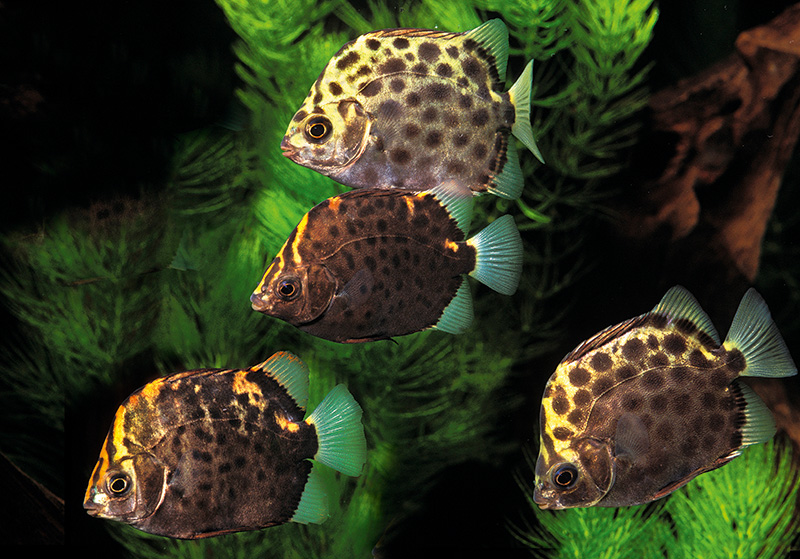Occasionally, in the recesses of oddball fish stores, you might come across a square-looking, silvery-green or red-hued fish that doesn’t look quite like the rest. There’s a good chance this will be Scatophagus argus, or the spotted scat.
From the off, it should be noted that there are two ‘types’ of spotted scat. Scatophagus argus has a subspecies — Scatophagus argus arromaculatus, offered under the common name of red or ruby scat. Care for both S. argus and its subspecies is identical and outward appearance is the only discerning feature between the two.
S. argus has endured, on and off, as a popular aquarium inhabitant for many decades in the aquarium hobby. This can largely be attributed to its relatively easy care (if some basic requirements are met) and interesting appearance, namely its bold spotting and laterally compressed body. This is a species I’ve come back to many times over my fish keeping journey and every time I am never left disappointed by a chance to re-explore it.
Water Chemistry
S. argus is naturally found in a varying array of environments, including full freshwater, intertidal zones, and marine environments.
As such, this species can be kept in a wide variety of water conditions, though brackish water is generally considered the most optimal water conditions for this species. Brackish water is a broad term that means water that has a higher salt content than that of freshwater and less than the marine environment. Think of the water in an estuary, where a river meets the sea.
When maintaining a brackish aquarium, a salinity of between 10–15ppt is usually a good starting point and is appropriate in regards to S. argus. More important than pinpointing one particular salinity as a starting point is that salinity’s stability in both the short and long term. Ensuring that water parameters are not constantly swinging is paramount, and that includes ensuring that salinity doesn’t drastically change with each Occasionally, in the recesses of oddball fish stores, you might come across a square-looking, silvery-green or red-hued fish that doesn’t look quite like the rest. There’s a good chance this will be Scatophagus argus, or the spotted scat.
From the off, it should be noted that there are two ‘types’ of spotted scat. Scatophagus argus has a subspecies — Scatophagus argus arromaculatus, offered under the common name of red or ruby scat. Care for both S. argus and its subspecies is identical and outward appearance is the only discerning feature between the two.
S. argus has endured, on and off, as a popular aquarium inhabitant for many decades in the aquarium hobby. This can largely be attributed to its relatively easy care (if some basic requirements are met) and interesting appearance, namely its bold spotting and laterally compressed body. This is a species I’ve come back to many times over my fish keeping journey and every time I am never left disappointed by a chance to re-explore it.
Always keep scats in groups, but add them all at the same time.
Dirty feeders
Scats are anything but a challenge when it comes to feeding time. S. argus is well known to be an unfussy feeder and if anything, care should be taken to ensure that other aquarium inhabitants are getting enough to eat when being kept with this greedy, fast-moving species.
The fish’s name gives us a clue into its natural mode of feeding — Scatophagus comes from skatos, which means dung, and phagus, which means to eat, and that’s exactly how unfussy this species can be. I have personally seen adult fish feeding on saltwater crocodile excrement when being kept together in a public zoo! Having said that, targeted feeding of scats is essential and they should not be considered as some sort of scavenging clean-up crew. Note too that they produce a fair amount of their own excrement, so filtration that can deal with a heavy bioload will be required.
Read the rest of the feature in the July issue, available to read instantly on our digital edition HERE or purchase the print edition HERE.
------------------------------------------------------------------------------------------------------------------------
Don’t miss an issue and subscribe! Practical Fishkeeping is Britain's best-selling fishkeeping publication, filled with species showcases, fishkeeping answers, advice, competitions, amazing features and much more!
We have a brilliant trial offer on both print and digital of JUST 99p for your first issue!
View the print offer HERE or go digital HERE.








